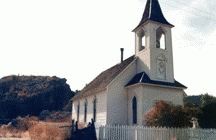THE PAST HANGS ON AT LONEROCK
Published 12:00 am Friday, May 18, 2007

- The lone rock that is Lonerock's namesake looms behind the town's 1898 church. ().
– Mark Highberger
Trending
– For The Observer
It’s a familiar photograph of a forsaken town: unpainted homes wearing wilted lawns and tangled weeds, broken-windowed businesses lining deserted streets, an empty church and school crouching beneath a storm-darkened sky.
Back in 1970, this image seemed to capture the last days of Lonerock, a town dying almost alone in the wheat country of north-central Oregon’s Gilliam County. Yet Lonerock, almost a century old when it posed for its deathbed portrait, refused to die. In fact, some say the town has never looked so good.
Trending
"It feels like the epitome of an All-American town," says a woman stopped in Lonerock just long enough to make lunch on the tailgate of her pickup. Nearby, stretched out among stems of bunchgrass that rustle in the wind, her German shorthair snoozes in the sun.
"Everywhere you look there’s fresh paint and new roofs." The woman waves a turkey sandwich toward the quiet street and the tidy homes that line it. "There’s just some good old-fashioned pride here."
Lonerock’s emergence from its ghost town past began in the last decade, when a number of new arrivals to Gilliam County discovered this half-mile high valley at the base of basalt mountains and junipered slopes. Here they made their new homes in the pastured bottomland where three creeks and three roads join. And before long, a new generation of Lone Rockers was rolling up its sleeves and sprucing up the place.
"Mostly it was people from Portland and California," says Laura Stevens, who spent her first six years or so in Lonerock, then moved away for almost 30 years before returning in 1991. "Now it’s pretty much a retirement town, people looking for a peaceful place to live."
These retirees follow a line of Lone Rockers that stretches back almost 130 years. That’s when George Boone a cousin to Daniel, some say and his wife Wealthy built the valley’s first cabin. Rough as that 1871 log home was, with its dirt floor and open windows, it marked the birth of Lonerock, which grew rapidly into an important crossroads trading center for the ranchers and sheepherders who followed.
Soon the growing population as many as 200 by 1880 could boast of having the area’s first school as well as its first band of sheep (1875), of becoming its first incorporated town (1882), of building a second school that housed all 12 grades (1888) and then erecting a wooden jail (1891) that held all the scoundrels, and of establishing its first church (1898).
Hulking up behind that church is the reason for the town’s name a lone rock (later spelled as one word) that measures some 60 feet across. And spreading out before it is the town itself, which once included a blacksmith shop and a livery stable, a hotel and a store, a boarding house and two saloons. As far as local government was concerned, somewhere along the way Lonerock’s citizens began the practice of appointing the oldest among them as mayor, and only the mayor’s funeral could bring about a change in administration.
Even though the town grew large enough to have a doctor, a lawyer and two ministers, the work of most Lonerockers involved either cattle or sheep. Even when the calendar flipped over to 1900 and the population grew to almost 230, Lonerock remained a center of the Gilliam County livestock industry. Evidently, it was a simple but challenging life.
"People back then just didn’t have money," says Stevens, who is writing a history of the town. "They were so poor they traded for the things they needed." Folks also depended on one other for their fun.
"Lone Rockers made their own entertainment," says a history of Gilliam County. "In the winter, with a good covering of snow, the homemade sleds would be brought out by young and old and a large bonfire built by the sledding slope."
When the snow melted, spring brought fishing and swimming in Lone Rock Creek, which flows through town; summer, community picnics and baseball games, with the Lone Rock Savages playing on a sheep-pasture diamond. In the fall, they even found time to cut loose a bit: "Come Halloween, the two-holers would be uprooted [or] a hack placed upon the roof of a local barn."
But by the second decade of the century, three forces began whittling away at the community the first World War, a dust bowl drought and the Great Depression.
"I think it was the Depression more than anything else," Stevens says. "People began moving out, looking for work."
And as people moved, businesses closed. Consequently, the school held its last graduation in 1932, and the jail released its last prisoner in the 1940s. Even the coming of electricity, which finally reached Lonerock in the 1950s, couldn’t stop the exodus.
With all its high schoolers riding a bus to Condon and only seven grade schoolers attending the white building on the hill, the school closed its doors for good in 1961. The post office followed two years later. Even the board sidewalks and wooden bridges left town, riding away with a flooding creek in 1964.
Although the surrounding ranching community remained relatively stable, the town itself slumbered on for two decades until the day when that small wave of new immigrants came rolling down the gravel road that cuts through the slopes leading into the valley, and Lonerock awakened to a changed community.
One of those changes is that of its 33 people, only 21 are full-time residents, including just three children; the rest come to town only on weekends or holidays. This means that even on a Sunday afternoon you might find no kids playing, no dogs barking and no barbecues smoking; nobody watering lawns, tilling gardens or washing cars.
Another change, according to Stevens, is that No Trespassing signs now post land once open to the community.
"I always wanted to come back to Lonerock," she says. "But when I did, I was disappointed because so many of the old people were gone."
She points out, however, that some Lonerockers still follow a pioneer lifestyle to some degree.
"I believe in the old days and the old ways of doing things," she says. "We still heat with a wood stove and hunt deer and elk for meat. Of course, I have a TV, but we still have our lanterns for when the electricity goes out."
So if you plan to visit Lonerock, fill your tank and pack your lunch, for the town has no store, cafe or gas station; you’ll find the school converted to a home, the jail preserved as an artifact, and the street filled with a quiet stillness that helps capture the sense of history surrounding this valley. In fact, some believe the pioneer settlers themselves still linger nearby.
"I’ve always said that the new people have chased the ghosts away," Stevens says. "But in my heart’s it’s still a ghost town. The old timers are still out there somewhere."









